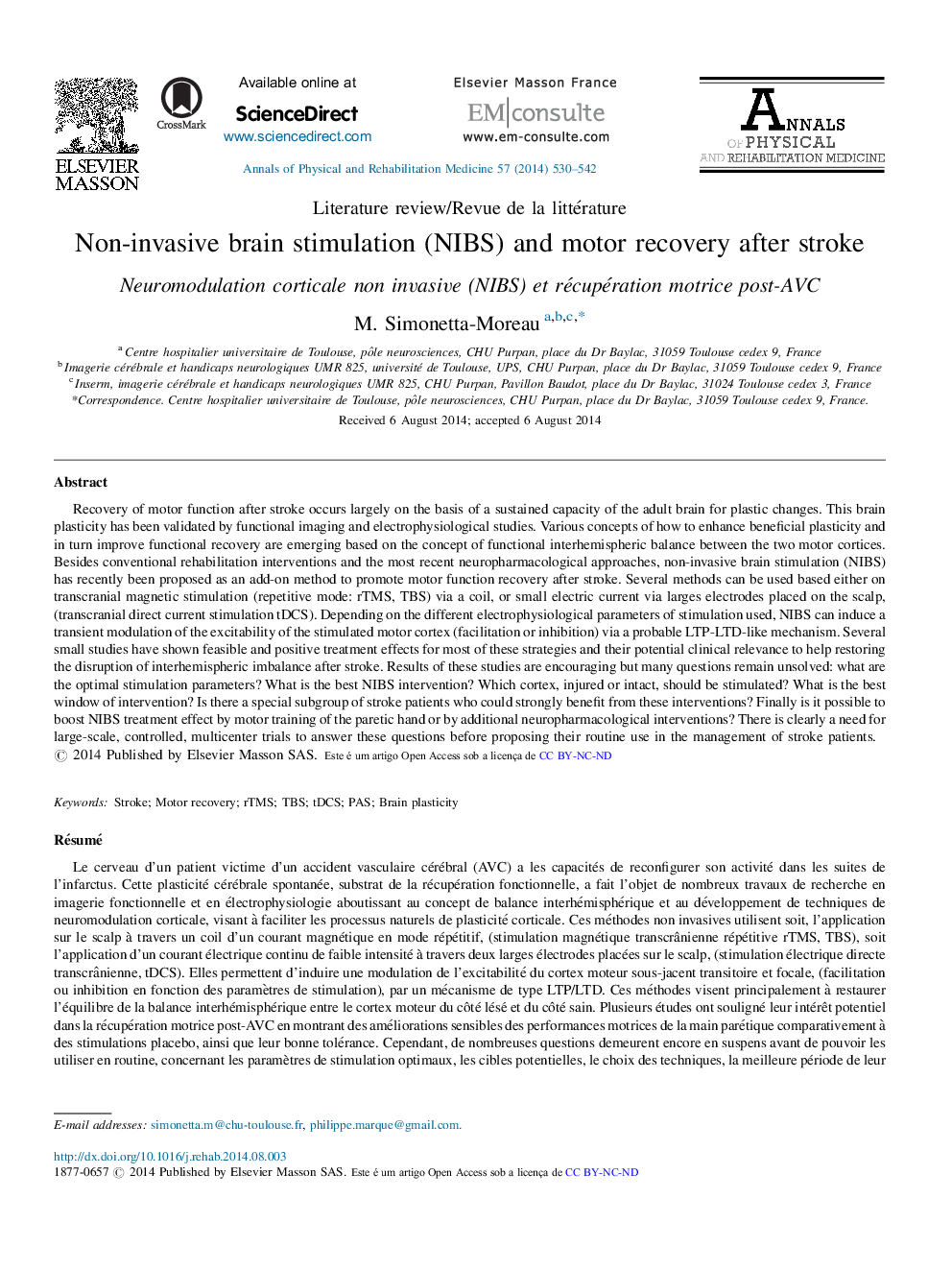| کد مقاله | کد نشریه | سال انتشار | مقاله انگلیسی | نسخه تمام متن |
|---|---|---|---|---|
| 6204005 | 1603305 | 2014 | 13 صفحه PDF | دانلود رایگان |

Recovery of motor function after stroke occurs largely on the basis of a sustained capacity of the adult brain for plastic changes. This brain plasticity has been validated by functional imaging and electrophysiological studies. Various concepts of how to enhance beneficial plasticity and in turn improve functional recovery are emerging based on the concept of functional interhemispheric balance between the two motor cortices. Besides conventional rehabilitation interventions and the most recent neuropharmacological approaches, non-invasive brain stimulation (NIBS) has recently been proposed as an add-on method to promote motor function recovery after stroke. Several methods can be used based either on transcranial magnetic stimulation (repetitive mode: rTMS, TBS) via a coil, or small electric current via larges electrodes placed on the scalp, (transcranial direct current stimulation tDCS). Depending on the different electrophysiological parameters of stimulation used, NIBS can induce a transient modulation of the excitability of the stimulated motor cortex (facilitation or inhibition) via a probable LTP-LTD-like mechanism. Several small studies have shown feasible and positive treatment effects for most of these strategies and their potential clinical relevance to help restoring the disruption of interhemispheric imbalance after stroke. Results of these studies are encouraging but many questions remain unsolved: what are the optimal stimulation parameters? What is the best NIBS intervention? Which cortex, injured or intact, should be stimulated? What is the best window of intervention? Is there a special subgroup of stroke patients who could strongly benefit from these interventions? Finally is it possible to boost NIBS treatment effect by motor training of the paretic hand or by additional neuropharmacological interventions? There is clearly a need for large-scale, controlled, multicenter trials to answer these questions before proposing their routine use in the management of stroke patients.
RésuméLe cerveau d'un patient victime d'un accident vasculaire cérébral (AVC) a les capacités de reconfigurer son activité dans les suites de l'infarctus. Cette plasticité cérébrale spontanée, substrat de la récupération fonctionnelle, a fait l'objet de nombreux travaux de recherche en imagerie fonctionnelle et en électrophysiologie aboutissant au concept de balance interhémisphérique et au développement de techniques de neuromodulation corticale, visant à faciliter les processus naturels de plasticité corticale. Ces méthodes non invasives utilisent soit, l'application sur le scalp à travers un coil d'un courant magnétique en mode répétitif, (stimulation magnétique transcrânienne répétitive rTMS, TBS), soit l'application d'un courant électrique continu de faible intensité à travers deux larges électrodes placées sur le scalp, (stimulation électrique directe transcrânienne, tDCS). Elles permettent d'induire une modulation de l'excitabilité du cortex moteur sous-jacent transitoire et focale, (facilitation ou inhibition en fonction des paramètres de stimulation), par un mécanisme de type LTP/LTD. Ces méthodes visent principalement à restaurer l'équilibre de la balance interhémisphérique entre le cortex moteur du côté lésé et du côté sain. Plusieurs études ont souligné leur intérêt potentiel dans la récupération motrice post-AVC en montrant des améliorations sensibles des performances motrices de la main parétique comparativement à des stimulations placebo, ainsi que leur bonne tolérance. Cependant, de nombreuses questions demeurent encore en suspens avant de pouvoir les utiliser en routine, concernant les paramètres de stimulation optimaux, les cibles potentielles, le choix des techniques, la meilleure période de leur application (phase aiguë, chronique), les critères de sélection des patients susceptibles d'en bénéficier et finalement leur place par rapport aux techniques conventionnelles de rééducation et les approches neuropharmacologiques.
Journal: Annals of Physical and Rehabilitation Medicine - Volume 57, Issue 8, November 2014, Pages 530-542